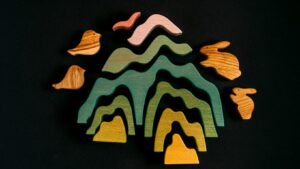Unleashing the power of the mind, tangram puzzles have long been celebrated as a masterful blend of art, geometry, and logic. From the classrooms to the living rooms, they’ve captivated the hearts of both the young and the young at heart, challenging their spatial reasoning and creativity.
Diving into the world of tangram puzzles is like embarking on a journey of discovery. It’s not just about arranging seven simple geometric shapes into a square or a silhouette of an animal. It’s about exploring the infinite possibilities that lie within these pieces, and the surprising complexity that emerges.
Tangram Puzzle Challenges
Tangram puzzle challenges are thought-provoking activities centered around a traditional Chinese dissection puzzle. In essence, these puzzles consist of seven flat pieces called ‘tans’, including two large, one medium, and two small triangles, one square, and one parallelogram. They demand participants to arrange these pieces into a distinct shape with their edges touching but without any overlaps. Tangram puzzle challenges present an array of shapes such as animals, people, everyday objects, or geometric patterns, making them multi-faceted and diverse.

One primary attribute of tangram puzzle challenges lies in their adaptability, offering puzzles with varying levels of difficulty. From simple creations to intricate designs, they bring diverse tests of spatial awareness and creativity skills. It’s not just a child’s plaything but a complex problem-solving exercise that engages the brain, invoking creativity underpinned by geometric principles.
Another striking quality is the perception of infinity it imparts. In the tangram world, the combinations are virtually endless. These challenges harbor countless solutions providing an infinite labyrinth of possibilities, fostering endless exploration and fostering a deep sense of intrigue and fascination among enthusiasts.
Benefits of Engaging With Tangram Puzzles
Tangram puzzles showcase a multitude of benefits that go beyond simple amusement. One gains Cognitive Flexibility through the task of arranging variegated shapes into different forms, enhancing strategizing abilities. Examples of such categorization involve transforming pieces into simple outlines of a cat or more complex geometric patterns.
An increase in Spatial Intelligence is another prominent boon. Users develop a deeper understanding of how shapes occupy space, becoming well-versed with principles of symmetry, rotation, and flipping. A clear exhibition of this benefit is when one succeeds in fitting all seven parts of a puzzle in an assigned template.

Problem-Solving aptitude certainly receives an uplift from these puzzles. The endless configurations demand constant tweaking of strategy, bolstering critical thinking. A prime instance of this boost is the moment when an intricate pattern is correctly formed after numerous trials.
The openness of tangram puzzles encourages out-of-the-box thinking, fostering a creative mindset. An instance of this growth can be seen when a player makes an unconventional image from the available shapes.
How to Solve Tangram Puzzle Challenges
Solving tangram puzzle challenges comes with its own set of strategies and tips. Begin by examining the seven distinct shapes comprised of two large triangles, two small triangles, a medium triangle, a square, and a parallelogram. Playing with the pieces, arranging and rearranging them, lays the groundwork for understanding how individual shapes interact to form complex designs.

Subsequently, focus on the puzzle’s outline. Make attempts to fit the larger pieces first, as they’ll cover significant portions of the space. Balance this strategy by incorporating the smaller pieces into gaps, following the geometric harmony of the configuration.
Benefit from shape manipulation abilities like flipping and rotating the pieces. Particularly, the parallelogram often requires a flip to fit into the puzzle properly. Differentiate, too, between size and shape: a piece may visually look like it fits, but its size may not match the space exactly.
Essentially, practice paves the way to master these puzzles. As one interacts more with tangram challenges, he becomes familiar with the geometric principles underpinning these puzzles, progressively improving their puzzle-solving prowess. Linking shapes to form specific configurations enhances spatial intelligence, enabling meaningful connections between the spatial, geometrical world of tangram puzzles and the world at large.

